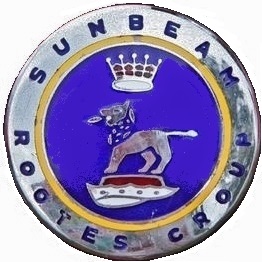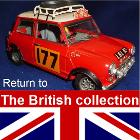
1960 Sunbeam Rapier
Having already revived Humber, Hillman and Commer it was the Rootes Group that stepped in to rescue Sunbeam in 1935. Rootes joined the Sunbeam and Talbot names together to offer a range of more upmarket sporting cars based on the Hillman series, and they were produced at Talbot's London Factory from 1938.
Produced from 1955 to 1976 the Sunbeam Rapier series covered three marks and was the first of the "Audax" models produced by the Rootes Motors ltd. Several months before the launch of the it's Hillman Minx and Singer Gazelle counterparts. Widely known as a sporty two-door Hillman Minx these cars sold very well although in most ways were merely an intelligent creation largely fished out of the Rootes Group parts bin. The similarities between the Minx and Rapier is self evident as is the influence of the Studebaker coupés of the early 1950s.
The first generation of the Rapier was released in 1955 as a sports saloon with four seats. It had the wishbone/coil over shock front suspension and overhead-valve 1390cc engine from the Hillman and a gearbox and standard overdrive based on that of the Humber Hawk. The engine had a higher compression ratio of 8:1 than the Minx, improved inlet and exhaust flow and a Stromberg DIF 36 carburettor allowing the unit to give 62.5 bhp at 5000 rpm. This could power the car from 0-60 in 21.7 sec's and a top speed of 85 mph. Although this performance was good for the era a 1956 upgrade of new inlet manifold and twin Zenith 36 WIP carburettors boosted output to 67.5bhp at 5000rpm.This raised the top speed by 3mph and slashed a second off the 0-60 time.
The pressed steel bodied Rapier looked very handsome with attractive two-tone colour schemes, leather trim and exotic American style column gear change. Interestingly the pressed steel body panels were transported to the north London plant of Thrupp and Maberley for trimming and painting then moved on to the Rootes assembly plant at Ryton-on-Dunsmore to have the running gear, transmission and engines fitted. Obviously a time intensive process the situation continued until late 1963! In all 7477 series I Rapiers were produced with a price of £1043-17s-0d (£1043.85), inc' purchase tax, as of March 1957.
Alongside the excellent handling characteristics the lively little Rapier became very popular and was soon taking to rally competitions.
Series II Rapier
Announced on the 6th of February 1958 the second series Rapier was made available as both a coupé and convertible. Some of the changes were more cosmetic, such as reintroducing a traditional Sunbeam radiator grille albeit in a slightly stylized form and accompanied by horizontal side grilles, and the more prominent rear wing fins. Other changes, like moving the gear change back down to the floor were for more practical reasons. The important changes were in the performance areas, a more powerful 1494cc engine (with raised compression ratio of 8.5:1 and larger inlet and exhaust valves providing 73bhp), a more precise recirculating ball steering box and larger front brakes. These changes were a direct reflection of the knowledge gained during competition and the engine was actually known as “the Rallymaster”. The coupé cost the same as the series one had but the overdrive unit was now an optional extra costing an additional £63-15s-0d (£63.75). 15,151 hardtop and convertibles were built when the series III model became available in 1959.
Series III Rapier
Rootes Motors Ltd. introduced this variant in September 1959 and was to become the definitive Sunbeam Rapier to many observers. What were individually quite small changes combined to creat a far more practical, luxurious and still very sporty car. Further cosmetic bodywork changes included the redesigned, narrower and lower, side flash with the Rapier script at its rear end. A more important but less obvious change was the lowering of the scuttle line and reduction in thickness of the A pillars which gave the driver 20% more windscreen area to aid his vision. The styling changes continued inside the car too. Deep pile carpets became standard and a new black plastic was used for the steering wheel, control knobs and dash; now featuring burr walnut veneer and black faced Jaguar instrumentation. The seats and interior panels were redesigned and now being a single coloured vinyl with piping in a contrasting colour. All of which looked much more upmarket than the previous two models.
Were the Series three really excelled was in the mechanical developments, largely being a result of crossover from the Sunbeam Alpine sports car. A new 8 port aluminium cylinder head further raised compression and housed a new sports camshaft. Although the same twin Zenith carburettors were still in use they now benefited from sitting on a new water heated inlet manifold. Power went up to 78bhp at 5400 rpm from the same 1,494cc size. The all-synchromesh gearbox was given higher ratios for 2nd, 3rd and top gears and the gear lever angle was reduced to give a better feel and quicker changes. 0-60 now took just 16.6sec's and top speed was pushing 92mph, some tests even put forward 93mph!
The front track was widened to further improve stability and road-holding and front disc brakes made for much improved stopping power.
Of both hardtop and convertible models 15,368 were produced costing £986 and the convertible for £1042-7s-6d (£1042.37). This model was superseded by the Series IIIA in the April of 1961.









